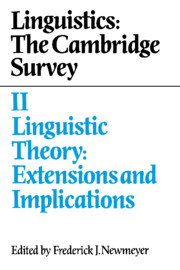Book contents
- Frontmatter
- Contents
- Contributors
- Preface
- 1 Extensions and implications of linguistic theory: an overview
- 2 Grammar and language processing
- 3 Grammatical principles of first language acquisition: theory and evidence
- 4 Second language acquisition and grammatical theory
- 5 Brain structures and linguistic capacity
- 6 Abnormal language acquisition and the modularity of language
- 7 Grammatical aspects of speech errors
- 8 Grammar and conversational principles
- 9 Discourse analysis: a part of the study of linguistic competence
- 10 Speech act distinctions in grammar
- 11 Computer applications of linguistic theory
- 12 Metrics and phonological theory
- 13 Grammatical theory and signed languages
- 14 The linguistic status of creole languages: two perspectives
- 14.I Creole languages and the bioprogram
- 14.II Are creoles a special type of language?
- 14.III A dialog concerning the linguistic status of creole languages
- Subject index
- Name index
- Contents of volumes I, III, and IV
3 - Grammatical principles of first language acquisition: theory and evidence
Published online by Cambridge University Press: 08 February 2010
- Frontmatter
- Contents
- Contributors
- Preface
- 1 Extensions and implications of linguistic theory: an overview
- 2 Grammar and language processing
- 3 Grammatical principles of first language acquisition: theory and evidence
- 4 Second language acquisition and grammatical theory
- 5 Brain structures and linguistic capacity
- 6 Abnormal language acquisition and the modularity of language
- 7 Grammatical aspects of speech errors
- 8 Grammar and conversational principles
- 9 Discourse analysis: a part of the study of linguistic competence
- 10 Speech act distinctions in grammar
- 11 Computer applications of linguistic theory
- 12 Metrics and phonological theory
- 13 Grammatical theory and signed languages
- 14 The linguistic status of creole languages: two perspectives
- 14.I Creole languages and the bioprogram
- 14.II Are creoles a special type of language?
- 14.III A dialog concerning the linguistic status of creole languages
- Subject index
- Name index
- Contents of volumes I, III, and IV
Summary
Introduction
The field of first language acquisition research came to life as a major branch of linguistics in response to Chomsky's (1959) claim that much of grammar is innate and that therefore all languages are, in some fundamental sense, the same. The initial goal of many researchers was devoted, perhaps simplistically, to either proving or disproving this proposition, particularly those who have sought to undermine the idea of grammatical universals. They attempt instead to ground language acquisition in general principles governing pragmatics and cognition. Others have been motivated by strictly non-theoretical aims; their work has been confined to the collection and cataloging of the undeniably fascinating data from child language. Indeed, as in most sciences, the data are, in a sense, ahead of the theory. A good deal of intriguing acquisition data lack an explanatory theoretical apparatus.
The hypothesis that underlies this chapter is that universal grammar (UG) will eventually explain all of the significant structural and semantic aspects of child grammar. The role of pragmatics and cognition, though intimately connected to language, will be seen to be external to the grammatical heart of language. The essence of language is a system of grammatical rules that interact with other aspects of mind in deceptively subtle ways. Our focus in this chapter, however, will not be on the interactions themselves, but rather on the more narrow goal of articulating how a grammar develops.
We will review acquisition research that sheds light on the precise sequence of hypotheses that a child entertains and on the acquisition path followed in grammar construction.
- Type
- Chapter
- Information
- Linguistics: The Cambridge Survey , pp. 35 - 52Publisher: Cambridge University PressPrint publication year: 1988
- 2
- Cited by



